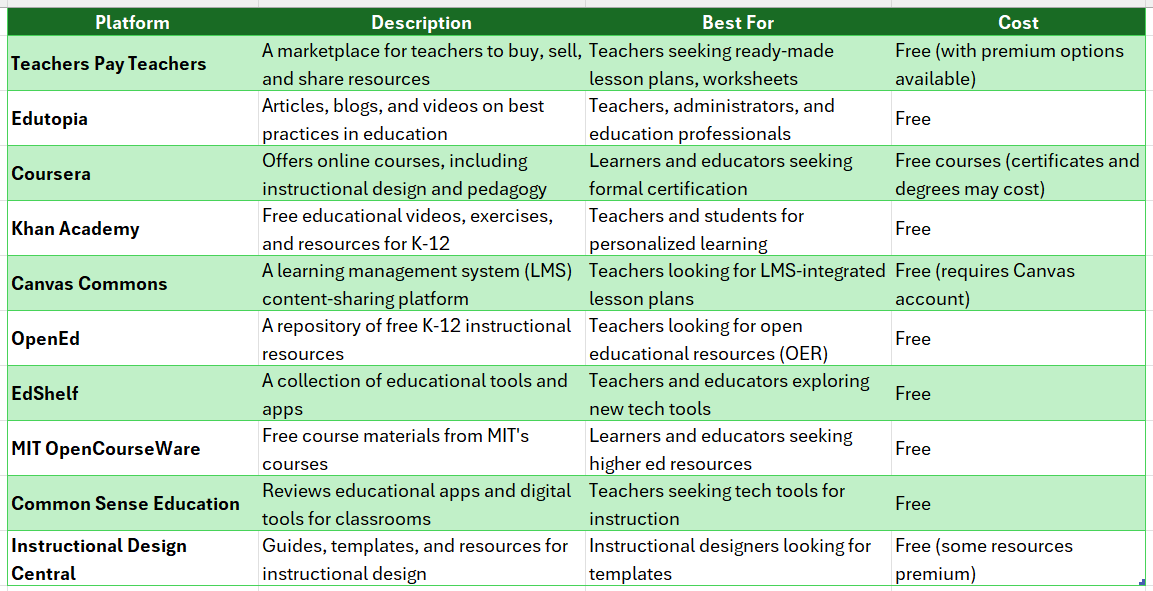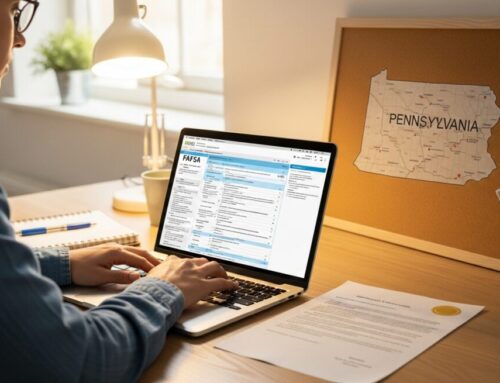
Finding free examples of instructional resources is essential for teachers, as these materials can significantly enhance lesson engagement and effectiveness. Whether you’re an experienced educator or new to the field, accessing quality resources can transform your teaching journey.
Online Platforms
- Teachers Pay Teachers: A well-known site where educators share free resources.
- Share My Lesson: Offers a variety of lesson plans and instructional materials.
- Khan Academy: Provides free lessons and exercises across subjects, ideal for tier 1 curriculum needs.
Educational Blogs and Websites
Numerous educational blogs feature free instructional resources. Seek out posts that showcase examples of instructional resources that align with your teaching objectives. These resources are particularly valuable for curriculum designers, especially those pursuing remote jobs. By exploring these platforms, teachers can discover a wealth of instructional materials tailored to diverse learning styles. Collaborating with fellow educators can also inspire new ideas and strategies. So, dive in and unlock the treasure trove of free resources available online!
Affordable, accredited education—Start now!
Why Free Examples of Instructional Resources Are Essential for Teachers
Finding free examples of instructional resources is crucial for teachers. These resources not only save time but also inspire creativity in lesson planning. With the right examples, educators can enhance their teaching strategies and engage students effectively. Let’s explore why these resources are essential.
Benefits of Free Instructional Resources
- Cost-Effective: Many teachers work with limited budgets. Free resources help them access quality materials without spending money.
- Diverse Options: From tier 1 curriculum to specialized lesson plans, teachers can find a variety of examples to suit different learning styles.
- Professional Growth: For those considering curriculum designer remote jobs, studying these examples can provide insights into effective curriculum development.
Where to Find These Resources
- Online Educational Platforms: Websites like Teachers Pay Teachers offer free resources shared by fellow educators.
- Educational Blogs: Many teachers share their instructional strategies and examples on personal blogs.
- Social Media Groups: Join Facebook or Reddit groups focused on teaching; members often share valuable resources.
Exploring Online Platforms: Your Go-To Sources for Instructional Resources

Finding free examples of instructional resources is crucial for teachers looking to enhance their lessons. With so many online platforms available, educators can easily access a wealth of materials that cater to various learning styles. This not only saves time but also helps in creating engaging and effective lessons.
Websites to Explore
- Teachers Pay Teachers: A popular site where educators share their resources, often for free. You can find examples of instructional resources that fit your needs.
- Khan Academy: Offers a variety of free instructional materials that align with tier 1 curriculum standards, making it a great resource for teachers.
- Edutopia: This site provides articles and examples that can inspire your teaching methods and resource creation.
By exploring these platforms, teachers can discover innovative ideas and examples of instructional resources. Plus, if you’re interested in curriculum designer remote jobs, these sites can help you build a strong portfolio. Remember, the right resources can transform your classroom experience!
Are You Utilizing Social Media for Educational Resources?
In today’s digital age, teachers are constantly on the lookout for free examples of instructional resources. These resources can enhance lesson plans and engage students more effectively. But did you know that social media can be a treasure trove for finding these valuable tools? Let’s explore how you can tap into these platforms to elevate your teaching game!
Social media isn’t just for sharing memes; it’s also a fantastic way to discover educational content. Here are some platforms to consider:
- Facebook Groups: Join groups dedicated to teaching and curriculum design. You’ll find a wealth of shared resources and ideas.
- Pinterest: Search for boards focused on tier 1 curriculum. Many educators share their favorite instructional resources here.
- Twitter: Follow hashtags like #EdChat or #InstructionalResources to connect with other teachers and find free materials.
By engaging with these communities, you can gather examples of instructional resources that fit your teaching style and needs. Plus, you might even stumble upon opportunities for curriculum designer remote jobs!
The Power of Teacher Blogs: A Goldmine of Instructional Examples
Finding free examples of instructional resources is essential for teachers looking to enhance their lessons. With so many options available, it can be overwhelming. However, teacher blogs are a fantastic place to start. They often share creative ideas and practical examples that can inspire your own teaching methods.
Why Teacher Blogs?
Teacher blogs are written by educators who share their experiences and resources. These blogs often include:
- Real-life examples of instructional resources
- Tips on implementing tier 1 curriculum effectively
- Insights into curriculum designer remote jobs, showcasing how to adapt lessons for various learning environments.
Benefits of Exploring Teacher Blogs
By diving into these blogs, you can:
- Discover innovative teaching strategies
- Access free downloadable resources
- Connect with a community of passionate educators
In conclusion, teacher blogs are a treasure trove of examples of instructional resources. They not only provide valuable content but also foster collaboration among teachers, making learning more engaging for students.
How to Navigate Educational Websites for Free Resources
Finding free examples of instructional resources is essential for teachers aiming to enhance their lessons affordably. With numerous educational websites available, it can be daunting to know where to begin. However, navigating these sites can uncover a wealth of materials to enrich your teaching experience.
Start with Reputable Sites
- Teachers Pay Teachers: This platform offers both free and paid resources, allowing you to filter searches for free instructional materials.
- Education.com: This site provides worksheets and lesson plans across various subjects and grade levels.
Explore Educational Blogs
Many educators share valuable resources through blogs. Searching for blogs in your subject area can lead to discovering unique tier 1 curriculum ideas for your classroom.
Join Online Communities
- Facebook Groups: These groups focus on teaching resources, where members share free materials and tips.
- Reddit: Subreddits like r/Teachers are excellent for finding free resources and advice on curriculum designer remote jobs.
By employing these strategies, you can easily access valuable resources to create engaging lessons for your students.
Collaborative Platforms: Sharing and Discovering Instructional Materials
Finding free examples of instructional resources is essential for teachers aiming to improve their lessons. The right materials help engage students and accommodate various learning styles. Collaborative platforms are invaluable for discovering and sharing these resources easily.
Online Communities
- Teachers Pay Teachers: A well-known site where educators share free resources.
- Edutopia: Provides articles and examples that can inspire teaching methods.
Social Media Groups
- Facebook Groups: Join teaching-focused groups where members share instructional resources.
- Pinterest: A visual platform for creative ideas and examples pinned by teachers.
By leveraging these collaborative platforms, teachers can find instructional resources and connect with peers. This networking can lead to opportunities like curriculum designer remote jobs, emphasizing the importance of sharing ideas. Additionally, exploring tier 1 curriculum materials ensures lessons align with educational standards.
Affordable, accredited education—Start now!
Local Libraries and Community Centers: Hidden Gems for Teachers
Finding free examples of instructional resources is essential for teachers looking to enhance their lessons. Local libraries and community centers often hold a treasure trove of materials that can inspire creativity and innovation in the classroom. These hidden gems can be a game-changer for educators, especially those in curriculum designer remote jobs.
Why Local Libraries?
Local libraries are not just about books. They often provide access to educational workshops, free resources, and even digital content. Teachers can find:
- Curriculum guides that align with tier 1 curriculum standards.
- Workshops on effective teaching strategies.
- Networking opportunities with other educators.
Community Centers as Resources
Community centers also offer valuable resources. They frequently host events and programs that focus on education. Here, teachers can discover:
- Hands-on activities for students.
- Collaborative projects with local organizations.
- Access to free materials that can be used in the classroom.
By tapping into these local resources, teachers can enrich their instructional strategies and provide engaging learning experiences for their students.
How ‘Degreesonline.education’ Can Enhance Your Search for Instructional Resources
Finding free examples of instructional resources is essential for teachers aiming to improve their lessons. With countless options available, it can be daunting. That’s where ‘Degreesonline.education’ simplifies your search, helping you discover valuable resources efficiently.
Discovering Quality Resources
- Curated Collections: ‘Degreesonline.education’ provides curated collections of instructional resources for various subjects and grade levels, making it easy to find what you need.
- User-Friendly Search: The platform features a user-friendly search function, allowing you to filter results by specific criteria like tier 1 curriculum or teaching strategies.
Community Contributions
- Teacher Contributions: Many educators share their resources on ‘Degreesonline.education’, offering real-world examples to inspire your curriculum design.
- Feedback and Reviews: You can access feedback from other teachers, ensuring you select high-quality materials that have been classroom-tested.
In conclusion, ‘Degreesonline.education’ is an excellent resource for teachers seeking free instructional materials, making lesson planning more accessible and effective.
Maximizing Your Search: Tips for Finding Quality Instructional Examples Online
Finding free examples of instructional resources is crucial for teachers looking to enhance their lessons. With the right resources, educators can create engaging and effective learning experiences. Plus, these examples can inspire curriculum designers, especially those in remote jobs, to develop innovative tier 1 curriculum materials.
Explore Educational Websites
Many educational websites offer free resources. Websites like Teachers Pay Teachers and Education.com provide a treasure trove of instructional examples. You can filter by grade level or subject to find exactly what you need.
Utilize Social Media
Don’t underestimate the power of social media! Platforms like Pinterest and Facebook groups are filled with teachers sharing their favorite instructional resources. Just search for keywords like “examples of instructional resources” to discover a wealth of ideas.
Join Online Communities
Consider joining online forums or communities. Websites like Reddit or specialized teacher forums often have sections dedicated to sharing resources. Engaging with fellow educators can lead you to hidden gems that you might not find elsewhere.
Affordable, accredited education—Start now!
FAQs
1. What are instructional resources?
Instructional resources are tools, materials, and resources used by educators to support teaching and enhance student learning. They include textbooks, multimedia, software, online platforms, and physical supplies that facilitate education.
2. Can you give examples of instructional resources?
Examples include:
-
Textbooks and workbooks: Traditional printed materials that provide structured content.
-
Online educational platforms: Websites or apps like Khan Academy or Google Classroom that offer interactive lessons and activities.
-
Multimedia: Videos, podcasts, and presentations that provide visual or auditory learning experiences.
-
Manipulatives: Physical objects like blocks, charts, or models used for hands-on learning (especially in subjects like math or science).
-
Assessments: Quizzes, tests, and rubrics used to evaluate student progress.
-
Teaching guides: Resources for educators that offer lesson plans, teaching strategies, and curriculum frameworks.
3. Why are instructional resources important?
They enhance the learning experience by providing diverse approaches to content, addressing different learning styles, and making learning more engaging and accessible for students.
4. Are digital tools considered instructional resources?
Yes! Digital tools such as learning management systems (LMS), educational apps, online courses, and virtual labs are all examples of modern instructional resources that support interactive learning.
5. How do instructional resources help students with special needs?
Specialized instructional resources, like assistive technology, modified learning materials, and personalized lesson plans, can be tailored to meet the unique needs of students with disabilities, ensuring they have equal access to learning.
6. Can instructional resources be used outside of the classroom?
Absolutely! Many instructional resources, especially online platforms and educational apps, can be used for homework, tutoring, or in after-school programs to reinforce learning outside of regular classroom hours.





